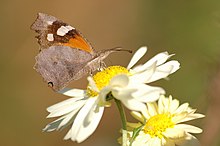Libytheana carinenta
| Libytheana carinenta | ||||||||||||
|---|---|---|---|---|---|---|---|---|---|---|---|---|

Libytheana carinenta , male |
||||||||||||
| Systematics | ||||||||||||
|
||||||||||||
| Scientific name | ||||||||||||
| Libytheana carinenta | ||||||||||||
| ( Cramer , 1777) |
American Snout Butterfly is a butterfly ( butterfly ) from the family of Nymphalidae (Nymphalidae) and the subfamily of the snout butterflies (Libytheinae).
description
butterfly
The wingspan of the moth is 35 to 50 millimeters. The jagged outer edge of the wings is striking. The color in the basal and Diskalregion is orange, in the Postdiskal- and Submarginalregion brownish. There are several white spots on the upper fore wing. The underside of the forewing shows a similar color pattern as the front, but a little more indistinct. The hind wing underside is light brown, gray brown, red brown or black brown marbled.
The very long, hairy palps that extend forward from the head and look like a snout or together with the antennae like the stem of a leaf are typical of the moths . The name American Snout Butterfly ("American snout butterfly") , which is used in English, results from this feature . When at rest, with folded wings, they resemble a withered leaf. The colorful front wings are hidden behind the rear wings. This camouflage means that they are well protected from predators.
egg
The eggs have an oval shape, a pale green color, are covered with ribs and are deposited individually on the young leaves of the food plants.
Caterpillar
Adult caterpillars have a green or yellowish basic color, wide yellow side stripes and are dotted yellow and white on the entire body surface. There are two small flat warts behind the head.
Doll
The tumbler varies depending on the area of occurrence in bright green, blue-green, yellow-green or brownish colors. Sometimes it is provided with white or yellow vertical stripes. A few white dots can be seen at the tips of the wing sheaths.
Similar species
There is a certain similarity to the hackberry butterfly ( Libythea celtis ), which, however, has fewer white spots on the upper side of the forewing. Since this species occurs only in Europe, North Africa and Asia, there is no geographical overlap with Libytheana carinenta .
distribution and habitat
The range of Libytheana carinenta includes the south of Texas and Florida , Central America as well as large parts of northern and central South America . Mass reproductions can occur at intervals of a few years. Up to 200 butterflies were observed resting on a tree. As migrating butterflies , they can even reach the east coast of Canada to the north . In 1921 approximately six billion moths roamed an area 250 miles on either side of the Rio Grande for 18 days . This corresponds to a rate of around one million butterflies per minute. The species prefers to live in subtropical forests and in landscapes overgrown with thorn bushes.
Way of life
In Florida and Texas, the moths fly year round in several generations. They like to suckle on different flowers to take in nectar. They also take fluids and minerals from damp areas of the ground, where they are sometimes found in large numbers, and also suckle on overripe fruits. The caterpillars feed on the leaves of hackberry trees ( Celtis ). The moths of the southern range overwinter.
Subspecies
The following subspecies are distinguished:
- Libytheana carinenta carinenta
- Libytheana carinenta bachmanii
- Libytheana carinenta larvata
- Libytheana carinenta mexicana
- Libytheana carinenta streckeri
swell
Individual evidence
- ^ Butterflies and Moths of North America http://www.butterfliesandmoths.org/species/Libytheana-carinenta
- ↑ a b c d e James A. Scott: The Butterflies of North America: A Natural History and Field Guide. Stanford, California: Stanford University Press, 1986, ISBN 0-8047-2013-4 , pp. 344-346
- ↑ Pictures of the caterpillar at "Bug Guide" http://bugguide.net/node/view/459956
- ↑ Distribution and subspecies http://www.nic.funet.fi/pub/sci/bio/life/insecta/lepidoptera/ditrysia/papilionoidea/nymphalidae/libytheinae/libytheana/index.html#carinenta
- ↑ mass reproduction http://www.cirrusimage.com/butterfly_snout.htm
- ^ Butterflies of Mexico. USA & Canada http://www.learnaboutbutterflies.com/North%20America%20-%20Libytheana%20carinenta.htm
- ↑ Subspecies http://www.butterfliesofamerica.com/t/Libytheana_carinenta_a.htm
literature
- James A. Scott: The Butterflies of North America , Stanford University Press, Stanford CA., 1992, ISBN 0-8047-2013-4 , pp. 344-346
Web links
- eol.org - Encyclopedia of Life


